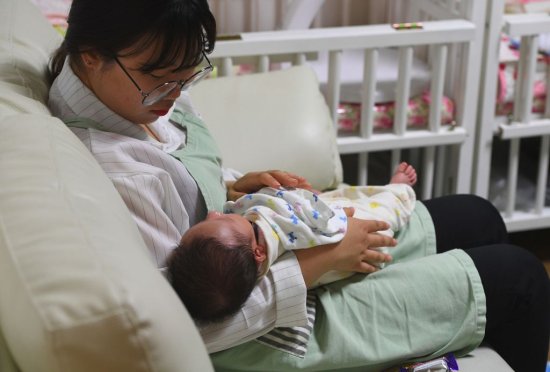
South Korea has spent millions on cash handouts for parents, but investing in quality-of-life improvement programs could be a more efficient approach.
South Korea—the world’s poster child for demographic decline—has spent some $280 billion over the past 18 years to address its diminishing birth rate, which recently dropped to a new record-low of 0.72 babies per woman in a lifetime. It’s a result of a confluence of factors but mostly comes down to young Koreans’ frustrations with high costs of living and low quality of life. But while cash handouts have been the government’s go-to approach, experts say that just throwing money at the problem isn’t necessarily the best solution.
[time-brightcove not-tgx=”true”]Since April 2022, South Korea’s government has handed out vouchers worth 2 million won (around $1,500) to parents who produce their first child, with another 3 million won dispensed for every additional child. In an effort to further subsidize the cost of childbearing and childrearing, the government has continued to increase its budget for family cash assistance. The monthly stipend parents receive for a newborn’s first year also increased in 2024 to a million won (around $740) from 700,000 in 2023. And since 2018, parents receive a 100,000 won ($74) handout every month for each child’s first several years. For a child born in 2024, parents are expected to receive—over eight years—at least 29.6 million won, or about $22,000, from the government.
Private companies have joined in on the campaign to boost birth rates via cash incentives, with some offering thousands of dollars for employees who reproduce—incentivized themselves by tax benefits and other government support measures for such programs.
“It’s just so much simpler to go to the cash incentive, to use that policy tool,” Jisoo Hwang, associate professor of Economics at Seoul National University, tells TIME. “I think for any government, that has been the easier way to address the low fertility problem.”
But Hwang and other analysts tell TIME that while handouts help, a better approach would be to focus on policies and programs that would address and improve broader quality-of-life issues. Such measures would bring their own unrelated benefits as well as indirectly help foster an environment where young people feel more inclined to have and raise children.
Hwang says policymakers should consider redirecting funds from handouts for individuals to the improvement of social services that benefit a larger collective of people. “It may be actually more efficient to, instead of giving out small increments of cash subsidies, if we can actually invest in public education or public childcare, and to enhance the quality and accessibility of that throughout the country,” she tells TIME.
To be sure, Seoul is making some moves along these lines to try to address quality-of-life problems. Last week, the government eased the burden on new parents seeking housing, with households that have children aged 2 or younger made eligible to special housing subscription systems in which the government allocates presale apartments through a raffle—a system that is considered the most cost-friendly way to purchase a house in South Korea, given high costs of real estate, especially in metropolitan areas. And earlier this year, President Yoon Suk-yeol announced that publicly funded after-school care programs for children would be expanded nationwide.
Also last week, Yoon oversaw the launch of a high-speed train that would reduce travel time between Seoul and its outskirts to less than a quarter of the original commute. Land Minister Park Sang-woo told Reuters that the new train was viewed as another tool that might improve birth rates: “With two-hour commute on the way home, for example, how can anyone make time for babies? The idea is to give people more leisure time after work.”
Hwang says the Yoon government’s non-cash-based approaches to tackling cost-of-living and quality-of-life issues for families indicate that it is taking the matter of declining birth rates seriously. But there’s a limit to how much any administration will prioritize long-term solutions—more fundamental changes to labor markets and education systems—whose results won’t likely be seen until they’re out of power.
At the same time, however, policymakers neeed to be wary of introducing non-cash solutions that could create new problems, says Stuart Gietel-Basten, a demographer and professor of social science and public policy at Hong Kong University of Science and Technology. For example, he says, if the new high-speed train makes commuting easier, companies may just expect workers to do more work in a culture where long hours on the job are already pervasive.
There’s also likely a limit to how much any of these programs can actually achieve. Demographers have previously warned that once fertility rates fall beneath a certain threshold, lifting them becomes extremely difficult because of self-reinforcing economic and social mechanisms. In the case of South Korea, authorities optimistically forecast the fertility rate will continue to decline, at least for the next two years before a projected slight uptick in 2026 that authorities believe will trend upward, albeit slightly, for the next decade. Yonhap reported in December that Lim Young-il, the head of the statistics office’s population trends division, attributes the current yearslong decline in South Korea’s birth rate, which he believes to be temporary, to the sharp decline in marriages at the height of the COVID-19 pandemic. Across Asia, marriages have started to rebound.
That’s not to say that continued investment in family-supporting programs is a waste. “By improving access to childcare, improving access to kindergartens, maternity leave, paternity leave, and so on and so forth, that has made people’s lives better,” Gietel-Basten tells TIME. “It may not necessarily have increased fertility. Maybe it will in time. But that’s not the [only] reason to bring in these kinds of policies.”